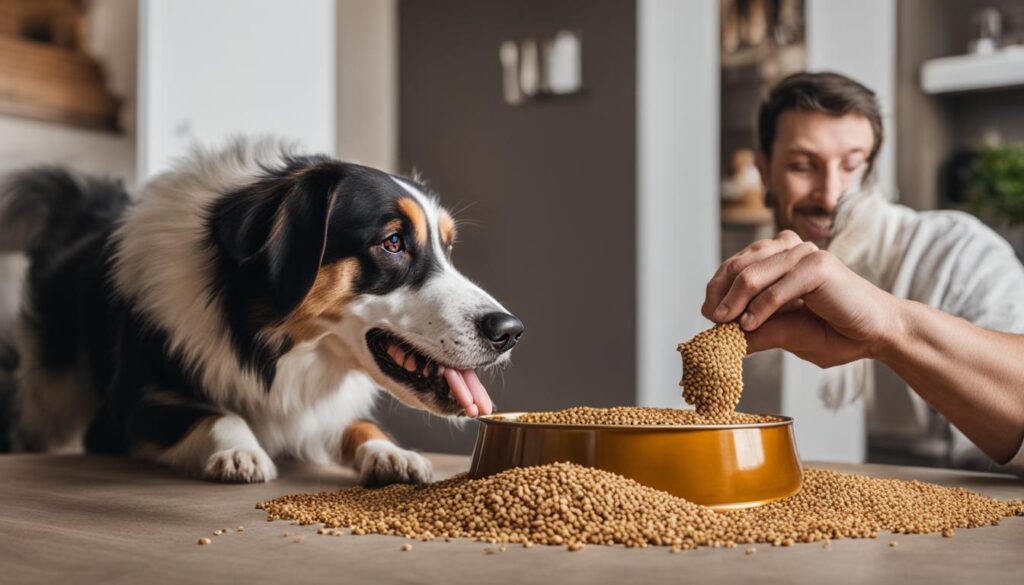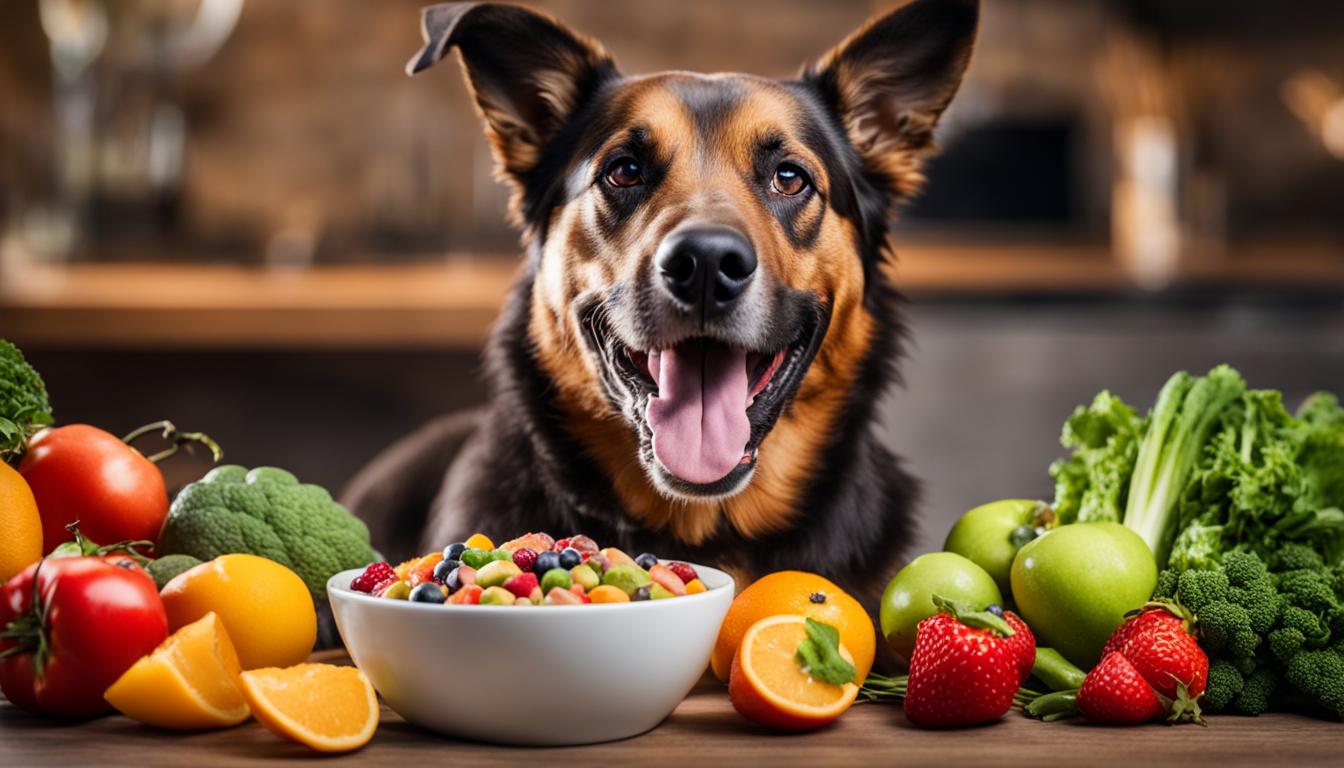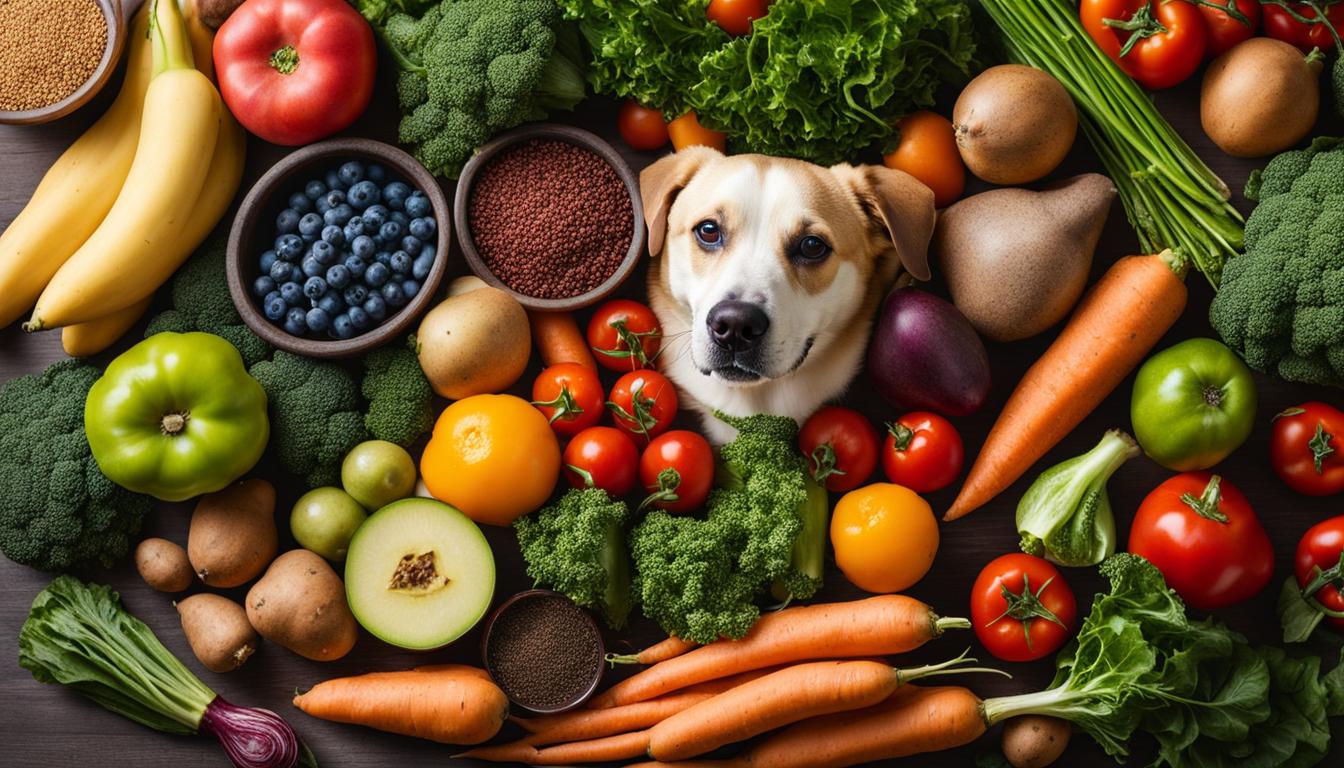Thinking about changing your dog’s diet? Transitioning your furry friend to a new food can be a bit tricky, but with the right approach, you can avoid any digestive issues and make the switch smoothly.
When it comes to transitioning dog diets safely, it’s crucial to take it slow. A gradual transition over 5-7 days is recommended to prevent gastrointestinal upset. Start by mixing a small amount of the new food with the old food and gradually increase the new food while decreasing the old food. Keep a close eye on your dog’s response during the transition, and if you notice any concerning signs such as changes in appetite, vomiting, or diarrhea, slow down the process even more.
Adverse food reactions can also occur, causing gastrointestinal and cutaneous symptoms in your dog. If you suspect a problem, your veterinarian may suggest an elimination diet trial to identify problematic foods. Monitoring your dog’s stool can also help evaluate their digestive health, with a fecal scoring chart providing guidance.
It’s essential to choose the right dog food for your furry friend. Consider factors such as their age, health, and personal preferences. Learning how to read a pet food label and understanding AAFCO labeling requirements can be beneficial in selecting the best diet for your dog. Of course, always consult with a veterinarian for accurate information about your dog’s health and nutrition.
Key Takeaways:
- Transition your dog’s diet gradually over 5-7 days to avoid digestive issues.
- Monitor your dog’s individual response and slow down the transition if needed.
- Adverse food reactions may require an elimination diet trial with your veterinarian’s guidance.
- Consider factors like age, health, and personal preferences when choosing the right dog food.
- Consult with a veterinarian for accurate information about your dog’s health and nutrition.
Reasons for Changing Dog Foods
When it comes to changing your dog’s food, there can be several reasons behind the decision. Whether you’re looking to provide a variety of flavors and textures, cater to specific dietary needs, or address health concerns, transitioning to a new dog food can be beneficial for your furry friend.
Gradual Diet Transition for Dogs: One common reason for changing dog foods is the need for a gradual diet transition. This can be especially important for dogs with sensitive stomachs or digestive systems. By slowly introducing the new food while gradually reducing the old food over a span of 5-7 days, you can help minimize the chances of gastrointestinal upset and ensure a smoother transition for your dog.
Transitioning to a Grain-Free Diet for Dogs: Another reason for changing your dog’s food might be a switch to a grain-free diet. Grain-free diets have gained popularity in recent years due to their potential benefits for dogs with specific dietary needs or allergies. By eliminating grains from the diet, these formulas provide an alternative option for dogs with sensitivities or those who thrive on a grain-free lifestyle.
Remember, each dog is unique, and consulting with a veterinarian is always recommended to determine the appropriate reasons for changing your dog’s food and to ensure that the new diet meets their individual nutritional needs.

Benefits of a Grain-Free Diet:
- May help with food allergies or sensitivities
- Potentially supports healthy digestion
- Offers a novel protein source for variety
Things to Consider Before Transitioning:
- Consult with your veterinarian to ensure a suitable switch
- Monitor your dog’s response during the transition period
- Gradually introduce the new food over the course of 5-7 days
- Choose a high-quality grain-free formula that meets your dog’s nutritional requirements
| Old Food | New Grain-Free Food |
|---|---|
| Contains grains and potential allergens | Grain-free formula with alternative carbohydrate sources |
| May cause digestive upset or allergies | May alleviate symptoms of food sensitivities or allergies |
| Traditional kibble texture | Alternative textures such as freeze-dried or raw options available |
How to Make the Switch
Transitioning your dog to a new diet requires a careful and gradual process to minimize digestive issues and ensure their overall health and well-being. Here are some guidelines on how to make the switch:
1. Start with a gradual transition
Begin by mixing a small amount of the new dog food with your dog’s current food. Gradually increase the ratio of new food to old food over the course of about a week. This slow transition allows your dog’s digestive system to adjust to the new food without causing upset stomach or diarrhea.
2. Consider different methods of transition
There are two main methods for transitioning your dog to a new diet: gradual switch and quick switch. The gradual switch is recommended for most dogs and involves slowly increasing the new food while decreasing the old food over several days. However, in some cases, such as a sudden dietary change due to health issues, a quick switch may be necessary. Consult with your veterinarian to determine the best method for your dog.
3. Troubleshoot common issues
If your dog experiences mild diarrhea, gassiness, or food refusal during the transition, there are steps you can take to address these issues. For mild diarrhea, you can try adding a small amount of plain canned pumpkin to your dog’s meals to help firm up the stools. If your dog is gassy, consider using slow-feed bowls or providing smaller, more frequent meals. If your dog refuses to eat the new food, try mixing in some low-sodium chicken broth or sprinkling a small amount of freeze-dried meat to entice them.
Remember, every dog is unique, and the transition process may vary. If your dog experiences severe symptoms or ongoing issues during the transition, it is important to contact your veterinarian for guidance and possible alternative diets.
| Common Issues | Troubleshooting Tips |
|---|---|
| Mild Diarrhea | Add plain canned pumpkin to meals. |
| Gassiness | Use slow-feed bowls or provide smaller, more frequent meals. |
| Food Refusal | Mix in low-sodium chicken broth or sprinkle freeze-dried meat. |
By following these guidelines and being attentive to your dog’s individual needs, you can make the switch to a new dog food successfully and ensure a healthy transition.
Why You May Want to Transition Your Pet to a New Food
If you have a senior dog, transitioning to a senior dog food is essential to meet their changing nutritional needs. As dogs age, their metabolism and digestion slow down, and they may require a diet that is lower in calories and fat. Additionally, senior dogs often benefit from diets that contain joint-supporting ingredients such as glucosamine and chondroitin.
For dogs with sensitivities or allergies, transitioning to a grain-free diet can be beneficial. Grain allergies are relatively common in dogs, and symptoms can include itching, skin irritation, and gastrointestinal issues. By switching to a grain-free diet, you can help alleviate your dog’s discomfort and improve their overall well-being.
If you have a picky eater or a dog with a sensitive stomach, introducing new foods can help diversify their diet and make mealtime more enjoyable. Dogs, like humans, can get bored with the same food day after day. By introducing new foods, you can stimulate their taste buds and provide them with a wider range of nutrients.
| Reasons to transition your pet to a new food |
|---|
| Transitioning to a senior dog food |
| Switching to a grain-free diet |
| Introducing new foods to sensitive dogs |
Remember, every pet is unique, and their nutritional needs can change over time. It’s important to consider factors such as age, health conditions, and individual preferences when deciding to switch your pet’s food. Consulting with a veterinarian can provide valuable guidance and ensure that the transition is done safely and effectively.
Expert Tip:
“When transitioning your pet to a new food, it’s important to do it gradually to minimize the risk of digestive upset. Start by mixing a small amount of the new food with their current food and gradually increase the ratio over the course of a week. Monitoring your pet’s response during the transition and seeking advice from a veterinarian can help make the process smoother and ensure their nutritional needs are met.”

How to Make the Switch: Troubleshooting and Safety Tips for Choosing the Best Pet Food
When it comes to transitioning your pet to a new food, a gradual approach is key to ensuring a smooth and successful switch. By following a few simple tips and considering your pet’s individual needs, you can make the transition easier and safer for them.
Step 1: Start with a Gradual Transition
To begin the transition, start by mixing small amounts of the new food with your pet’s current food. Over the course of about a week, gradually increase the ratio of new food to old food. This gradual approach allows your pet’s digestive system to adjust and helps minimize the chances of gastrointestinal upset.
Step 2: Monitor Your Pet’s Response
Throughout the transition, keep a close eye on your pet’s response to the new food. Look for any signs of gastrointestinal distress, such as changes in appetite, vomiting, or diarrhea. If you notice any concerning symptoms, slow down the transition process and go back to a higher ratio of the old food.
Step 3: Troubleshooting Common Issues
During the transition, it’s not uncommon for pets to experience issues like food refusal, mild diarrhea, or gassiness. If your pet refuses to eat the new food, try mixing in some of their favorite flavors or gradually increasing the amount of new food over a longer period of time. If your pet experiences mild diarrhea or gassiness, consider adding probiotics to their diet or consulting with a veterinarian for further guidance.
Choosing the best pet food is crucial for your pet’s overall health and well-being. Consider factors such as their age, breed, and any specific dietary requirements they may have. Read pet food labels carefully and look for products that meet AAFCO (Association of American Feed Control Officials) requirements. Consulting with a veterinarian can also provide valuable insights and personalized recommendations for your pet’s specific nutritional needs.
| Transition Tips | Troubleshooting | Choosing the Best Pet Food |
|---|---|---|
|
|
|
By following these tips and taking your pet’s individual needs into account, you can ensure a safe and successful transition to a new food. Remember to always consult with a veterinarian for personalized advice and recommendations based on your pet’s unique circumstances.
Tips for Changing Your Dog’s Diet and Avoiding Digestive Issues
Switching your dog’s diet can be a delicate process, and it’s important to do it in a way that avoids digestive issues and ensures a smooth transition. Here are some tips to help you navigate this change:
1. Gradual Transition:
When changing your dog’s diet, it’s best to do it gradually over the course of about a week. Start by mixing a small amount of the new food with their current food and gradually increase the ratio of new food to old food. This allows your dog’s digestive system to adjust to the new food without causing any discomfort or upset.
2. Monitor Your Dog’s Response:
Pay close attention to your dog’s individual response during the transition period. Keep an eye out for any concerning signs such as changes in appetite, vomiting, or diarrhea. If you notice any of these symptoms, it’s important to slow down the transition process and give your dog’s digestive system more time to adapt.
3. Find a Similar Formula:
When changing your dog’s food, try to find a new formula that is similar to their current one. Consider their favorite flavors and ingredients to maintain familiarity and lessen the chances of food refusal or gastrointestinal upset. Sticking with the same manufacturer can also provide consistency in quality and formulation.
By following these tips, you can help your dog transition to a new diet without experiencing any digestive issues. Remember, consulting with a veterinarian is always recommended for personalized advice and guidance based on your dog’s specific needs. Your furry friend’s health and well-being should always be the top priority.
| Potential Issues | Recommended Actions |
|---|---|
| Food Refusal | Try mixing in some wet food or adding a small amount of warm water to make the new food more enticing. If the issue persists, consult with a veterinarian. |
| Mild Diarrhea | Slow down the transition process and give your dog’s digestive system more time to adjust. If the diarrhea persists or worsens, seek veterinary advice. |
| Gassiness | Introduce the new food gradually and consider adding probiotics to your dog’s diet to support digestive health. If the problem continues, consult with a veterinarian. |

“A smooth transition to a new diet is essential for your dog’s digestive health and overall well-being. With these tips, you can make the switch as comfortable and stress-free as possible.”
How to Find a Similar Formula When Changing a Dog’s Food
When switching your dog’s food, it’s crucial to find a similar formula that maintains familiarity and minimizes digestive upset. Consider the following factors to ensure a smooth transition:
- Favorite Flavors: Take note of your dog’s preferred flavors and look for new food options that offer similar tastes. This will increase the chances of your dog accepting the new food more readily.
- Ingredient Lists: Compare the ingredient lists of the old and new food. Look for similarities in protein sources, grains, fruits, and vegetables. This will help maintain consistency in your dog’s diet and minimize potential allergic reactions or digestive issues.
- Manufacturer Reliability: Sticking with the same manufacturer can provide reassurance in terms of quality and consistency. Research the manufacturer’s reputation for producing reliable and nutritious pet food.
“Finding a similar formula helps maintain consistency in your dog’s diet and minimizes potential allergic reactions or digestive issues.”
However, it’s important to note that finding a similar formula may not always be possible or necessary, especially when transitioning to a prescription diet or introducing new foods to sensitive dogs. In such cases, consulting with a veterinarian is recommended to ensure the right match is found for your dog’s specific dietary needs.
Table: Key Factors in Finding a Similar Formula
| Factors | Considerations |
|---|---|
| Favorite Flavors | Choose new food options that offer similar tastes to your dog’s preferred flavors. |
| Ingredient Lists | Compare and match protein sources, grains, fruits, and vegetables to maintain consistency in your dog’s diet. |
| Manufacturer Reliability | Stick with a reputable manufacturer to ensure consistent quality and reliable nutrition. |
By considering these factors and consulting with a veterinarian, you can find a similar formula when changing your dog’s food and ensure a smooth transition that keeps their diet enjoyable and nutritious.
Conclusion
Transitioning your dog’s diet safely is crucial to ensure their overall health and well-being. By following these tips and tricks, you can make the switch smoothly and avoid digestive issues. Start with a gradual transition over 5-7 days, gradually increasing the amount of new food while decreasing the old food. Monitor your dog’s response and proceed more slowly if any concerning signs occur.
It’s also important to choose the right dog food based on factors like age, health, and personal preferences. Learn how to read pet food labels and understand AAFCO labeling requirements to make an informed decision. Consulting with a veterinarian is always recommended for accurate information about your dog’s health and nutrition.
Remember, managing your dog’s diet transition safely involves paying attention to their individual needs and seeking professional advice. Troubleshoot common issues with food refusal, mild diarrhea, or gassiness, and make adjustments as necessary. By taking these steps, you can ensure a successful and safe transition for your beloved canine companion.
FAQ
Why is it important to transition your dog’s diet gradually?
Changing your dog’s diet requires a gradual transition to avoid gastrointestinal upset and allow their digestive system to adjust to the new food. This transition should take place over 5-7 days, gradually increasing the amount of new food while decreasing the old food.
How should I monitor my dog’s response during the diet transition?
It is important to monitor your dog’s individual response during the transition. Proceed more slowly if any concerning signs such as changes in appetite, vomiting, or diarrhea occur. If severe symptoms persist or worsen, it is advisable to contact a veterinarian for advice and possible alternative diets.
What are the possible symptoms of adverse food reactions in dogs?
Adverse food reactions in dogs can cause gastrointestinal and cutaneous symptoms. If your dog experiences symptoms such as vomiting, diarrhea, excessive itching, or skin irritation, it may be necessary to consult with a veterinarian, who may recommend an elimination diet trial to identify problematic foods.
How can I evaluate my dog’s digestive health?
Monitoring your dog’s stool can help evaluate their digestive health. A fecal scoring chart can provide guidance on what a healthy stool should look like. If you notice any significant changes in your dog’s stool consistency or appearance, it is recommended to consult with a veterinarian.
What factors should I consider when choosing a new dog food?
Choosing the right dog food can be complex. It is important to consider factors such as age, health, and personal preferences. Learning how to read a pet food label and understanding AAFCO labeling requirements can also help in selecting the best diet for your dog. Consulting with a veterinarian is always recommended for accurate information about your dog’s health and nutrition.
Why might I need to change my dog’s food quickly?
Quick switches are necessary in cases such as food recall, unavailability of current food, or veterinary recommendation due to allergies or health conditions. In such situations, it is important to make the switch swiftly while monitoring your dog’s response and seeking veterinary advice if any concerns arise.
What is rotational feeding and when should it be considered?
Rotational feeding involves routinely switching between different foods to provide increased variety and minimize the chances of nutrient deficiencies or contamination. It may be considered when transitioning to a different budget-friendly food, different food type (dry, wet, grain-free), or life-stage food.
Why is consulting with a veterinarian important when changing your dog’s food?
Each pet is unique, and consulting with a veterinarian is essential to determine the appropriate reasons for changing your dog’s food. A veterinarian can provide valuable insights about your dog’s health, nutritional needs, and any specific dietary restrictions or considerations that need to be taken into account.





